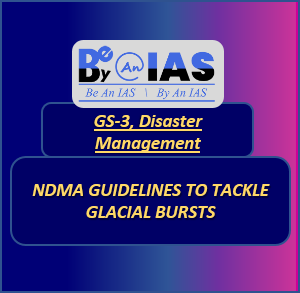CURRENT AFFAIRS
Get the most updated and recent current affair content on Padhaikaro.com
NDMA GUIDELINES TO TACKLE GLACIAL BURSTS
- Be N By IAS, Delhi
- 10, Feb 2021

For : GS-3: Disaster Management
CONTEXT:
Flash floods hit Uttarakhand’s Chamoli district on Sunday, due to a suspected glacier break.
This has come months after the PM Narendra Modi-led National Disaster Management Authority (NDMA) issued guidelines detailing the measures to reduce and deal with disasters stemming from Glacial Lake Outburst Floods (GLOFs).
GUIDELINES ISSUED BY NDMA FOR RISK REDUCTION:
Geo Mapping: First step is to identify and map such lakes.
Structural improvements: Then taking measures to make structural improvements that would prevent these dams from sudden breaches.
Mechanism at Vulnerable beach: Moreover, for events where such a breach occurs, a mechanism would need to be put in place to save lives as well as property.
Identifying potentially dangerous lakes: Field observations, the lakes’ and dams’ geomorphologic and geotechnical characteristics, and records of past events can help in identifying lakes that are potentially dangerous.
Use of Synthetic-Aperture Radar imagery Meanwhile: NDMA has also suggested that changes in water bodies, like formation of new lakes, can be automatically detected with the help of Synthetic-Aperture Radar imagery.
Remote monitoring of lake bodies: The authority also said that remote monitoring of lake bodies could also be carried out from space by putting in place methods and protocols for the same.
Moreover, pumping, siphoning out water or controlled breaching can be used to reduce the volume of water in such lakes, which would help in structural management of these water bodies.
Apart from that, a tunnel can also be constructed under an ice dam or through a moraine for this.
INDIA’S PREPARATION:
- There has been some work that has been carried out to identify such lakes.
- On robust early warning system as well as the framework for development of infrastructure and construction and excavation in vulnerable areas are still a work in progress.
- NDMA said that India did not have uniform codes for construction, excavation or grading, as against other countries.
- It added that an effective way to reduce risk from GLOF, a no-cost method is to restrict construction and development in vulnerable areas. Moreover, habitation in prone areas should also be prohibited, the NDMA had said.
- On the other hand, even globally the number of implemented and operation early warning systems for GLOFs is very small, and in the Himalayan region, there are only three reported instances of the implementation of monitoring and sensor-based technical systems for GLOF early warning, and of these, one is in China and two are in Nepal.
- Meanwhile, India has a great history of successful warnings regarding Landslide Lake Outburst Floods (LLOFs), and this dates back to the 19th century.